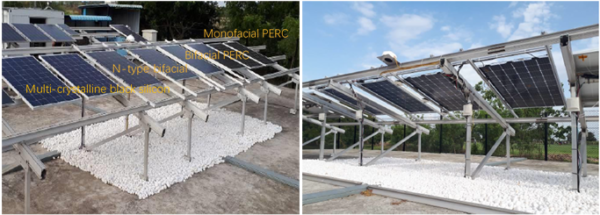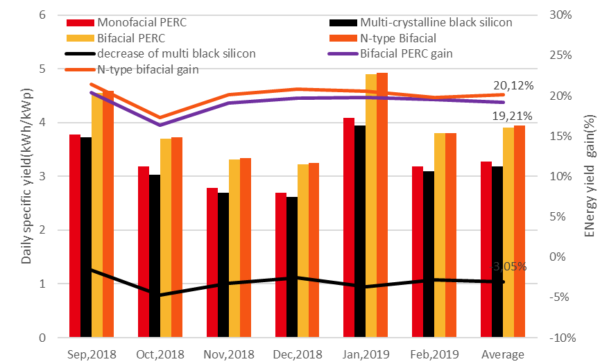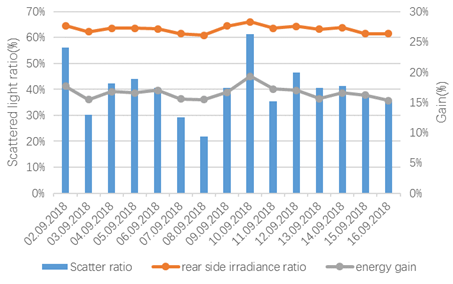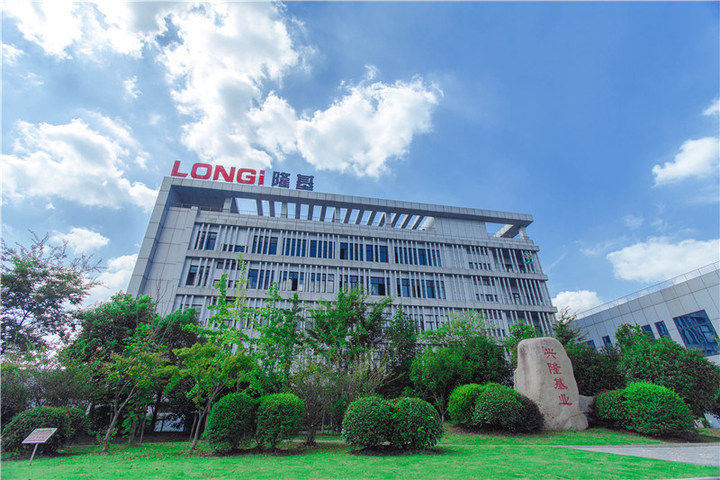In a bid to verify claims about the potential energy yield gains offered by bifacial solar modules, Chinese panel giant Longi Solar joined forces with German testing institute TÜV Rheinland to install eight modules and record performance.
The installation was made in September last year at Chennai, in southeastern India, and Longi this week published the results of the first six months of testing in a white paper.
The installation comprises two panels each of four different module types: single-sided and bifacial PERC modules made by the Chinese manufacturer as well as multicrystalline black silicon products and n-type, frameless bifacial models, supplied by unnamed producers. All were installed on fixed-tilt racking at a 15-degree angle a meter above ground. White gravel was added below the bifacial modules. The pilot also features a pyranometer to measure frontside irradiance and three installed on the rear, to measure irradiance at heights of 1m, 1.2m and 1.4 m.

The chart below illustrates the energy yield of the four module types for the six-month period between September 2018 and February.
Longi said both bifacial modules greatly outperformed single-sided products – the bifacial PERC module achieved a 19.21% yield gain and the double-sided n-type product recorded a 20.12% gain, compared to the yield from Longi’s single-sided PERC product.

The single-sided PERC module outperformed its multi-cSi black silicon panel by 3.05%, a performance Longi attributed to PERC’s better temperature coefficient and low-irradiance performance.
Of the two bifacial modules, Longi said the 0.76% higher yield for the n-type module was mainly down to its being frameless. Longi’s bifacial module has a frame, which causes unavoidable shading on the rear side. Longi said without the frame, the generation capacity of the two products would have been “basically the same” and noted the frame offers advantages in long-term reliability. The manufacturer added, the p-type bifacial PERC module is currently cheaper than n-type technologies.
Data from the testing site also indicated bifacial boost was considerably higher on days with more scattered sunlight. The following chart illustrates the rear-side irradiation, power generation gain and sunlight scattering ratio for a two-week period in September 2018, demonstrating the higher the ratio of rear-side to front-side irradiation, the higher the bifacial boost.

Longi also noted the bifacial gains demonstrated in its data were generally stable over the six months, with the dip seen in October 2018 visible in the first chart above attributed to a power breakage.
On-site data from bifacial installations is a much sought-after commodity, with the developers of energy yield models seeking to validate their assumptions and create models which can accurately calculate the yield of bifacial installations. pv magazine investigates this issue further in our November print edition and in a webinar to be held on Tuesday, November 12th. Register for free here.
This content is protected by copyright and may not be reused. If you want to cooperate with us and would like to reuse some of our content, please contact: editors@pv-magazine.com.




How much more are they and who sells them in Australia?
A key issue not addressed in the article is the addition of white gravel underneath the bifacial modules. The industry needs further testing that includes ground cover with different albedos (reflectivity) to assess performance under real-life conditions, particularly since we are unlikely to cover large land areas under multi-MW solar projects with different ground cover, for economic and/or environmental reasons.
An additional (minor) point is that the test should have put white gravel under the mono-facial arrays as well, to create more of an apples-to-apples test, since even monofacial arrays may see performance effects from high-albedo ground surfaces.